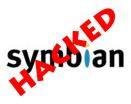
Forgot your memory card password? If you set your phone free you can read your memory card password from a file on your internal phone memory.
Your memory card password is stored in C:\sys\data\mmcstore (this folder only exists if you've set a memory card password).
Switch "caps" off (Symbian hack required), use a file manager like X-plore or ActiveFile to copy the file to another location, and open it in a text editor like LightNotepad.
Your password appears at the end of a line that starts with some cryptic code. Suppose your password was NOKIASUX, then it will appear in LightNotepad as XXXXXXXxxx]NOKIASUX.
If your password has numbers or other strange characters, there may be question marks in between them. Just ignore those question marks. If you open the file in Notepad on a computer with Windows, there will be spaces in between the characters of your password.
Friday 31 October 2008
Recover lost memory card password
Thursday 30 October 2008
PyFolder: easy access to your Python scripts
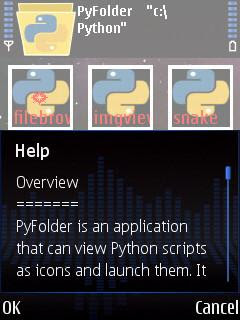
Some Python applications come as .sis installers with an icon that you can put anywhere you like in your Symbian menu.
But some Python scripts require a trip to the Python program and the "run script" menu option.
PyFolder gives you a faster, easier way to launch those Python scripts by making a virtual folder with Python script icons. It also lets you set any .jpg file you like as icon for any Python script.
If you have lots of Python scripts that you run often, PyFolder is a must have application on your phone, even though its animated background is a bit annoying.
Needless to say, you need to have Python installed to use PyFolder.
• PyFolder
• Nokia's Python page
• Python on SourceForge
• Signed Python on Symbian Freak
Wednesday 29 October 2008
Access Symbian system folders from your computer

This trick appeared last month in the modding section of the Symbian Freak forum, but because that's a members only area which is not indexed by search engines like Google I'll repeat it here.
If you connect your Symbian phone to your computer with PC Suite you can only see childproof folders like images, sounds, documents, etc.
But there is a way to get into system folders like resource, private, and sys too.
What you need:
- A hacked phone with "caps" switched off.
- MapDrives on your phone.
- PC Suite on your computer.
Step 1: Make sure Symbian on your phone is hacked and "caps" are switched off.
Step 2: Use MapDrives to assign virtual drive letters to your Symbian system folders.
Step 3: Connect your phone to your computer in PC Suite mode.
Step 4: Open "My Computer," and open Nokia Phone Browser. Do NOT open the drive with the phone symbol, and do NOT open your phone's drive from the PC Suite menu. Only use the Nokia Phone Browser from "My Computer."
Step 5: Your mapped system folders will show up as drives in the Nokia File Browser, and you'll have full access to all the files in them.
• The original post on Symbian Freak that explains this trick (signup/login required)
• MapDrives
• Nokia PC Suite
• Hack Symbian: The methods, the tools, the tricks
Tuesday 28 October 2008
Delete stuck installers and themes, remove share online from active standby, recover 5 MB of phone memory by deleting a useless placeholder file

Sometimes you'll want or need to remove things from your phone but Symbian won't let you. There are ways to make your Symbian phone know that you're the boss. Some of these methods require that you hack your copy of Symbian, others don't.
• Delete stuck installer files from memory card (no hack needed)
Your application manager may contain references to .sis files which are not installed and which can not be removed. This can happen if a program fails to install, or if you reset your phone. To get rid of these stuck installers, you'll need to remove them manually.
You'll need access to your memory card from your computer by bluetooth, USB cable, or card reader.
1) Connect your phone to your computer in data transfer mode (a.k.a. mass storage). Do NOT choose PC Suite mode.
2) Tell your computer to show hidden files and folders.
3) Navigate to \private\10202dce on your memory card and remove the .sis files that appear as "not installed" in the application manager.
• Delete stuck installer files from memory card or phone memory (for hacked phones)
Your application manager may contain references to .sis files which are not installed and which can not be removed. This can happen if a program fails to install, or if you reset your phone. To get rid of these stuck installers, you'll need to remove them manually.
You'll need a hacked phone and a Symbian file manager like Active File or X-plore.
1) Make sure your phone is hacked and "caps" are disabled.
2) Use a Symbian file manager like Active File or X-plore to navigate to C:\private\10202dce (phone memory) or E:\private\10202dce (memory card) and remove the .sis files that appear as "not installed" in the application manager.
• Remove themes that don't appear in the application manager from your memory card (no hack needed)
Sometimes you install a theme, want to remove it, and are unable to because the theme doesn't show up in the application manager. You can remove these themes yourself.
You'll need access to your memory card from your computer by bluetooth, USB cable, or card reader.
1) Connect your phone to your computer in data transfer mode (a.k.a. mass storage). Do NOT choose PC Suite mode.
2) Tell your computer to show hidden files and folders.
3) Navigate to \private\10207114\import on your memory card.
4) Browse the subfolders of \private\10207114\import. The .mbm, .mif, and .skn files in each folder usually have the same name as the theme itself.
5) If the names of the files do not look like the theme name at all, open the .skn file in a text editor like Notepad. The name of the theme is somewhere in the first one or two lines of text.
6) When you've located the folder of the "missing" theme, remove all files in it. Do NOT remove the folder itself, only remove the files.
7) If you have new firmware, you'll also find bits and pieces of the theme in the folder \resource\skins. Remove the files from there as well.
• Remove themes that don't appear in the application manager from your memory card or phone memory (for hacked phones)
Sometimes you install a theme, want to remove it, and are unable to because the theme doesn't show up in the application manager. You can remove these themes yourself.
You'll need a hacked phone and a Symbian file manager like Active File or X-plore.
1) Make sure your phone is hacked and "caps" are disabled.
2) Use a Symbian file manager like Active File or X-plore to navigate to C:\private\10207114\import (phone memory) or E:\private\10207114\import (memory card).
3) Browse the subfolders of \private\10207114\import. The .mbm, .mif, and .skn files in each folder usually have the same name as the theme itself.
4) If the names of the files do not look like the theme name at all, open the .skn file in a text editor like Notepad. The name of the theme is somewhere in the first one or two lines of text.
5) When you've located the folder of the "missing" theme, remove all files in it. Do NOT remove the folder itself, only remove the files.
6) If you have new firmware, you'll also find bits and pieces of the theme in the folder \resource\skins. Remove the files from there as well.
• Remove "share online" from your active standby screen (for hacked phones)
Share Online is a Nokia service to upload pictures, video, and text to blogs, photo sharing sites, etc.
If you recently updated your firmware, or if you have a very new Nokia, you may have noticed that there's a "share online" entry that eats up valuable space on your active standby screen. It's very easy to remove Share Online from a phone with a hacked copy of Symbian.
You'll need a hacked phone, Python, and onlshSwitch.
1) Make sure your phone is hacked, "caps" are switched off, Python is installed on your phone memory, and the active standby screen mode is switched off.
2) Run onlshSwitch and remove "share online" from your active standby screen.
3) Switch your active standby screen back on.
This doesn't work on all Nokia phones.
• Remove "share online" from your active standby screen (no hack needed, tested on Nokia N82 and N95)
If you recently updated your firmware, or if you have a very new Nokia, you may have noticed that there's a "share online" entry that eats up valuable space on your active standby screen. You can get rid of it by installing a beta test version of Share Online, and then removing it.
Details here.
This doesn't work on all Nokia phones
• Recover 5 MB of internal phone memory (for hacked phones)
Deep down in the dungeons of the Symbian system folders sits a 5 MB placeholder file called reserved.bin. This space is only used if you do an "over the air" firmware update. If you update your phone from your computer, you don't need this file and you can delete it to gain five extra megabytes of phone memory.
You'll need a hacked phone and a Symbian file manager like Active File or X-plore.
1) Make sure your phone is hacked, "caps" are switched off.
2) Use a Symbian file manager like Active File or X-plore and navigate to C:\Private\102072c4.
3) Delete the file reserved.bin.
4) Make an empty text file called reserved.bin and drop it into C:\Private\102072c4.
5) If you open "device manager" in your settings folder, the file may reappear.
• Some of these tricks are based on posts in the modding section of the Symbian Freak forum (signup and login required)
• How to hack Symbian: tutorials and more
• A collection of Symbian tricks
Monday 27 October 2008
Kill camera shutter sound on old Nokias without feature pack 1 or 2
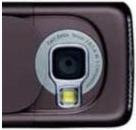
Do you hate that annoying camera shutter sound on your Symbian phone? You're not alone. Fortunately there are ways to shoot pictures without camera noise.
The easiest way: install cCam to make pictures without sound. Unfortunately this program gives you way less options than the native camera application, and cCam doesn't shoot video.
But if you hack Symbian you have more options.
If you have a Nokia N82, N95, or another Nokia that has the file z:Sys\Bin\CamMojave.exe, just hack your phone and use this ROMPatcher method to silence your camera.
If you have a Nokia E66, E71, N82, N95, 6120 Classic, 6110 Navigator, or another Nokia with the file z:\sys\bin\camcorder.exe, hack your phone and use this method to keep your camera quiet.
But what if you have an older phone like the Nokia 5500 or N73 that doesn't have feature pack 1 or 2? This old version of Symbian is also known as Symbian 9.1 S60 version 3.0. Yes, I know, the Symbian and S60 numbering schemes are totally ridiculous.
For those old phones there's another ROMPatcher method.
Step 1: hack your phone, install ROMPatcher on it, and disable "caps" in the options menu of ROMPatcher. You'll find detailed tutorials on symbianhack.site666.info.
Step 2: Download and install the C before Z patch. Installation instructions are in the text file that comes with the download.
Step 3: Download this camera patch file and use a program like ActiveFile or X-plore to copy it into E:\patches on your memory card.
Step 4: Download these silent sound files and copy them into C:\System\sounds\digital.
Step 5: Open ROMPatcher, select "Patch" in the options menu, and activate the camera patch.
• This tutorial is based on the instructions in the closed modding section of the Symbian Freak forum.
• Check the camera sound label for ways to fight the camera shutter sound.
Sunday 26 October 2008
Jbak TaskMan updated, now signed

Task manager, program launcher, and system info viewer Jbak TaskMan reached version 0.99. Jbak TaskMan gives you many more options than Symbian's built-in task manager. For example, Jbak TaskMan lets you see hidden tasks, memory status, disk usage, and detailed task info. Bugs were fixed, options added, and the program is now signed so you can install Jbak TaskMan without having to waste time on the Symbian Signed bureaucracy.
• Jbak TaskMan site
Saturday 25 October 2008
GMail 2.0: Multiple accounts, offline browsing, cosmetic and speed improvements

Reading your mail with Google's mobile email application is faster and easier than using your mobile web browser to get into your GMailbox.
New in version 2.0:
- support for multiple GMail accounts,
- offline browsing: latest mails are stored on your phone, you only need a connection for sending mail and retrieving old messages,
- smoother scrolling,
- other cosmetic improvements.
There's still no native Symbian program, though, so Google's mobile GMail client has all the limitations of a mobile Java application.
GMail:
• Google's mobile GMail client
• Mobile GMail site
Want to use your GMail account to store files?
• GSpaceMobile
Friday 24 October 2008
Make your Symbian phone talk to your Linux computer
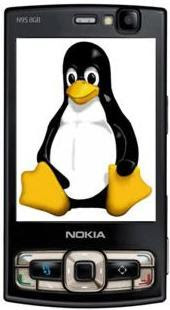
Nokia is extremely Windows minded. That makes sense, because the market share of both Nokia and Symbian (largest shareholder: Nokia) makes Nokia a sort of Microsoft of the smartphone business, which leaves users of other operating systems out in the cold. Sure, Nokia made a few programs to provide a bit of totally inadequate Mac support, but they've never programmed a single line of code to make your Symbian S60 phone talk to Linux. Sony Ericsson? LG? Motorola? They're as guilty as Nokia.
To make things worse for Linux users, PC Suite doesn't work under WINE.
There are ways to close the communication gap a little. Wammu is like a kind of bare bones PC Suite for Linux. Unfortunately most of its features don't work with new Symbian phones.
• Wammu (front-end to Gammu)
KMobileTools and gnokii are older attempts at mimicking PC Suite functions. KMobileTools uses the Gammu engine (you're better off with Wammu), gnokii only works with old versions of Symbian, not with S60 3rd ed. or UIQ.
• KMobileTools
• gnokii
Phone Manager may turn into a Linux PC Suite, but in its current state it can only send SMSs from your computer through your phone:
• Phone Manager
Joomla! is a site with tricks to transfer files from your Nokia to your Linux computer and back, use your Nokia as a modem, and more. But prepare for lots of typing on the command line.
• Joomla!
Smoking Linux has a tutorial that explains how to transfer files from your Linux computer to your phone memory. Lots of command line typing.
• smihael
Windows users can synchronise their phone with Outlook. But who wants to use outlook anyway when you can sync your phone with Mozilla Thunderbird on your Linux box?
• bluZync: synchronise your phone with Thunderbird over bluetooth
• bluZync user forum (you may need this, because bluZync doesn't work just right out of the box and their FAQ is not ready yet)
Tuxmobil.org has a list of Linux programs for older Nokias.
• TuxMobil
There's no Linux version of Nokia Map Loader, but there's a Nokia Map Loader Alternative that works on Linux (and on any other operating system too!):
• Nokia Map Loader Alternative
Updated on February 3, 2009.
Found some missing links? Did I forget something? Feel free to leave a comment or hit the contact link at the bottom of this page.
Thursday 23 October 2008
New Nimbuzz doesn't drain your battery as fast as before
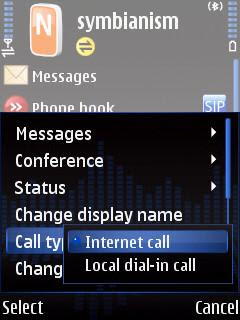
Mobile multi network instant messenger and VoIP client Nimbuzz lets you chat and call on Skype, does voice calls with almost every VoIP service that handles standard SIP calls, and connects to AIM, GoogleTalk, Jabber, MSN, and Yahoo for chats, file transfers, and voice chats too.
The big orange icon is ugly as ever: an eyesore in your menu and on your active standby screen. But the program did improve. The new Nimbuzz version 1.0 has a slightly altered menu structure, a few more preconfigured SIP providers (did they pay Nimbuzz for the exposure?), and offline chat options for more networks than before.
But the number one reason to update your copy of Nimbuzz: it's power consumption has gone down a bit, so your battery lasts a little longer.
For the time being, Nimbuzz is ahead of fring in terms of battery life, memory requirements, and sound quality. But the world of mobile VoIP and chat spins fast, so stay tuned.
Nimbuzz:
• Nimbuzz
Nimbuzz alternatives:
• fring
Update: fring is no longer a multi-network messenger. They kicked 'em
all out, fring now only works on it's own fring network. My advice:
don't use fring.
• Talkonaut (Talkonaut doesn't do Skype)
Wednesday 22 October 2008
New fat fring: a lot bigger, a little better
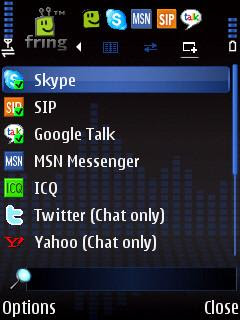
Just arrived: the new improved version of multi-network instant messenger program, GMail notifier, VoIP application, Skype client, and Facebook tool fring.
What's new?
The download is a little bigger than it used to be. Once installed on my Nokia, fring 3.36 occupied no less than three times more space than version 3.35: fring grew from barely 0.75 MB to well over 2 MB. If you have an older phone with fierce competion for real estate on your overcrowded internal phone memory, you may want to relocate fring to the roomy suburbs of your memory card. If you're low on RAM, fring alternative Nimbuzz could be for you.
What do we get for those extra bits and bytes? As promised by fring on their blog, the user interface looks a little sexier. The program launches with a list of your contacts. Nothing new here, so on to the next step: the add-ons tab. This screen lists all the instant messaging and VoIP services with colorful icons, little green checkmarks to indicate services you're subscribed to, and a new menu option to make those icons and the text that sits next to them very big.
You can scroll through the tabs with your navigation button or move straight to any tab (including open chat windows) with the "go to" entry in the options menu.
Fring also promised some bug fixes under the hood. These are invisible, but I trust they're there anyway.
A few suggestions for a future better fring:
1) Move the "go to" entry one or two flights up in the options menu of the add-ons tab. I'm sure people will use this feature way more often than the icon size toggler that currently lives near the top floor.
2) Add a bit more info to the "about" screens of the add-ons. There's plenty of space over there, so why not make it show which user account is used, and which VoIP provider is programmed to handle your SIP calls?
3) Put the settings, change connection, help, and exit entries in the options menu of the add-ons tab too.
4) Storing multiple SIP accounts... don't you think it's about time, fringers?
Fring is a great all-in-one instant messenger/Skype client/VoIP application. VoIP calls on Skype and SIP sound better with Nimbuzz, and instant messaging works better on IM+ (expensive) or Slick (free while beta testing lasts). But when it comes to combining text chats, voice calls, and file transfers in one single program that doesn't cost a penny, fring is still the best Jack of all trades.
fring:
• fring site with all info and download details
• straight to the fring download page (tip: you don't need to enter a real email address in the "get fring via PC" box)
Update: fring is no longer a multi-network messenger. They kicked 'em
all out, fring now only works on it's own fring network. My advice:
don't use fring.
the competition (which is certainly not sleeping):
• Nimbuzz for instant messaging, Skype, and other VoIP services
• Talkonaut for instant messaging and VoIP, but not for Skype
Tuesday 21 October 2008
Turn your 3G phone into a wireless router with JoikuSpot Light
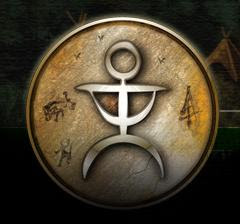
JoikuSpot Light connects your 3G connection with Wi-Fi to turn your mobile phone in a wireless router. So if there's no open Wi-Fi signal around but your phone can go online by 3G (UMTS etc.), you can share your phone's internet connection with your laptop, PDA, or iTouch without having to deal with cables, complex programs, etc.
New in the latest version of JoikuSpot Light: more languages, automatic reconnection when your 3G connection drops, and JoikuSpot Light now works with the latest lineup of Nokia phones that come with feature pack 2.
Something that should have changed but didn't: Joiku still can't handle WPA wireless encryption. That means you can only secure your connection with the obsolete WEP method, which is easily cracked by those in the know. So better check who's in range before you send any sensitive data over your wireless Joiku connection.
JoikuSpot Light is free, but only supports http and https. In plain english, this means that you can use JoikuSpot Light to surf the web, but not for email of the POP or IMAP type used by email programs like Thunderbird or Outlook. And not for P2P file sharing, media streaming, or FTP either. For some of these things there are standard www alternatives (webmail, for example), but if you can't live with the limitations of JoikuSpot Light there's a €15 premium version that does all the internet protocols.
• JoikuSpot Light at joiku.com (free, but limited to http and https)
I couldn't find any useful info on the Joiku site about a trial version of JoikuSpot Premium. Where to get it, how long does the trial last, can you test all features, that sort of thing. Mobile Castle has a way to take JoikuSpot Premium for a test drive for those who want to try before you buy and know how to install unsigned Symbian programs:
• JoikuSpot Premium at Mobile Castle (unofficial trial edition, no limits)
Monday 20 October 2008
Better late than never: Nokia Map Loader for Mac OS X (Leopard only). Now what about Tiger, Linux, and Symbian?

Nokia Map Loader has seen many updates, bug fixes, and even a new feature or two. And of course Nokia managed to squeeze a shop for navigation licenses and city guides into their loader program.
But some things didn't change. Some recycled text from an old blog entry:
The old requirement for Windows with .net framework is still there. It still won't work on Mac or Linux systems. You still can't download maps over WiFi or 3G with the Symbian browser of your phone. In terms of unnecessary overhead, Nokia Map Loader is still as badly designed as ever. All those megabytes won't even tell you which maps you already have installed on your phone. And if you update one map, the new map loader still erases every other map you already had loaded on your phone so you'll have to download all of them all over again.
All these issues remain unfixed. Well, almost all. Because after what seemed like eternity, Nokia finally made a version of their Map Loader for Mac.
The new Mac version of Nokia Map Loader (MacLoader? iMaps?) is in early beta testing stage, so it is still full of bugs, erors, flaws, SNAFUs and other nasty little things to keep Nokia's programmers off the streets. With a cold finnish winter coming up that's not necessarily a bad thing ;)
Issue one: Map Loader for Mac is not for all Macs. You'll need Leopard, the latest version of Mac OS X. This is the equivalent of a Windows program that doesn't work on Windows XP. Some quotes from visitors of Nokia's Beta Lab blog:
- will there be a Tiger version? [Nico]
- Sorry, no plans for a Tiger version. [Steve A, product manager of Map Loader for Mac]
- No Tiger version = not for me. It’s like developing for Vista only. [Sergey Zak]
- Another vote for Tiger support! [Akos Polster]
- There should be at least 10.4 compatibility. [Ilgaz]
- ...after waiting patiently for 19 months I am somewhat miffed to discover you are ignoring OS X 10.4 users. So I guess there is no point in hanging on for any other PC Suite applications...? [Golux]
Issue two: that noisy iTunes won't keep quiet:
- Can maploader disable iTunes transfers temporally, I don’t want it to be looking and transfering songs while I’m using map loader. [Fernando]
- Oh apparently you cant cancel the “Preparing iTunes transfers” or else Map Loader does not work [Fernando]
- Get Nokia Media Transfer to be more silent about transferring things when I’m using Map Loader.[Fernando]
- We have a new version of NMT coming which will improve the interaction [Steve A, product manager of Map Loader for Mac]
Issue three: not all Nokia phones seem to understand MacSpeak.
- Nokia N95: This phone doesn’t seem to work with Nokia Map Loader [Fernando]
- I have tried Map Loader for Mac 1.0. on my Mac running 10.5.5 and connected to my N95-1 V30.0.015 with Nokia Maps 2.0 but it will not work! I get a message saying “The phone does not seem to work with Nokia MapLoader” This is somewhat disappointing. [Atlantean]
- When my E51 is connected via USB I start the loader which begins to search installed maps on the phone. This seems to work. Then the program tries to download something from the Maps website - and fails: “Map catalogue loading failed Map Loader couldn’t download the list of available map regions…” [olive]
- I’m using a 6120 and I’m getting the error: Map catalogue loading failed. Map loader couldn’t download the list of available map regions. Possible causes include a lack of network connectivity or a problem on the maps server. [Phil]
- Doesn’t xork for me on my N82 [oNico®]
- It doesnt wor on my E71 (110.07.27) [...] “Map catalogue loading failed. Map Loader couldn’t download the list of available map reagons….” [Herbert]
Issue four: there's more than Windows and Mac alone. Unanswered questions from the Nokia Beta Labs site:
- Linux, anyone? [And now...]
- Is there any intention to make softwares to work with Linux? [MaXeR]
- Linux - Not today. [Steve A, product manager of Map Loader for Mac]
Issue five: Nokia Map Loader is a closed source program. According to the feedback on Nokia's blog, that's not a good thing:
- It’s sad that Nokia think they’re doing something good by releasing SW for the Mac … Just publish the specs, protocols, fileformats etc. and let the opensource community have a go at it. We’d have Windows, Mac, Linux, BSD and possibly even S60 (think about it, who needs an extra computer, when, say, a N82 is so powerful by itself) maploaders by now … [Erling Jacobsen]
Nokia Map Loader for Mac is far from ready yet. The same applies for the old PC version too. But at least it's a small step in the right direction.
And Steve A, the product manager of Map Loader for Mac, has a refreshing view on Map Loader alternatives: "We are not trying to create a monopoly on Map downloading. BTW you mention about checking the server for updates. That is actually in the Map Loader. As for deleting specific countries off of the device, yes it is something we would like to do, but not for version 1.0."
That's a welcome change after Nokia's attempts to force the Nokia Map Loader Alternative offline.
Choose your weapon. Your options are:
Nokia Map Loader for Windows
- Required operating system: Windows XP or Windows Vista (Win2K or earlier won't work)
- Required extra software: Microsoft .net framework
Nokia Map Loader for Mac
- Required operating system: Mac OS X Leopard (Tiger or older won't work)
Required extra software: Nokia Multimedia Transfer version 1.3 or higher
Nokia Map Loader Alternative
- Required operating system: anything you like
- Required extra software: any web browser you like
• Nokia Maps (official site)
• Nokia Map Loader for Mac at Nokia Beta Labs (halfway official)
• Nokia Map Loader Alternative (as unofficial as it gets)
Sunday 19 October 2008
Lock access to your phone apps with ActiveLock
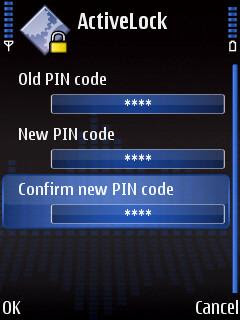
The web browser of your Symbian phone stores cookies with login details, credit card numbers, and other personal info that you wouldn't want to fall into the wrong hands.
And do you have one of those multi network instant messaging programs on your phone that makes life easy by remembering your login names and passwords? An email program? Is there anything in your calendar or the Symbian Notes application that you don't want to share with everyone? What about your Skype and other VoIP login info stored by fring or Nimbuzz? All the messages from your girlfriend that your wife shouldn't read?
Enter ActiveLock by Alie Tan, who also gave us the Jack of all trades file manager ActiveFile.
ActiveLock lets you set PIN code for any program you like, so that only you can use them. Your girlfriend, teenage son, mother, parole officer, or that asshole of a thief who's gonna steal your phone tomorrow... with ActiveLock on your phone nobody will be able to launch all those applications with sensitive data if they don't know your PIN.
ActiveLock works on just about every Symbian 60 Nokia out there. It's still new and experimental and in beta testing and unsigned, but with your own developer certificate, a trip to Open Signed Online, or the hack that allows you to ignore Symbian Signed completely you can install ActiveFile on your phone and keep the unwanted out of your data.
• ActiveLock on alietan.com
Saturday 18 October 2008
A folder of new Nokia Maps

The people at Nokia who make Nokia Maps and Nokia Map Loader don't like me. And I guess they don't like Trek1701 anymore either.
Because Trek1701 hit the "contact" link at the bottom of this page and wrote that he caught Nokia's Map Loader pulling its maps from a new folder. They used to come from 0.0.12h, a subfolder of maploaderzip on static.s2g.gate5.de. But now the maps come from 0.0.13h.
In good old Nokia style, the powers that be at Nokia HQ didn't deem us mortals worthy of a change log. So we can only guess what's new. Better maps? More details? Better coverage of the long and winding roads of Calcutta and Manila? Or is it just a celebratory folder switch because of the brand new map loader for Mac OS X Leopard?
If you find anything new in Nokia's latest maps, please hit the contact link at the bottom of this page. Nokia won't like it, but the rest of the planet will.
The new maps are all available through the Nokia Map Loader Alternative.
Trek1701, thanks for the update!
• Nokia Maps (official site)
• Nokia Map Loader for Mac at Nokia Beta Labs (halfway official)
• Nokia Map Loader Alternative (as unofficial as it gets, now with the latest maps from the new folder)
Friday 17 October 2008
To The Point: TTP shows your favourite pictures with a minimum of clicks
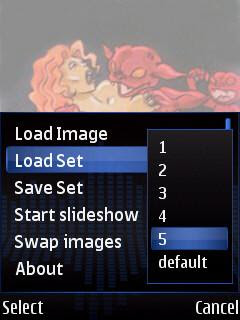
Do you have hundreds of pictures on your phone's memory card? Do you hate the way Symbian's built-in gallery has a coffee, picks its nose, spanks its monkey, smokes a cigarette, and keeps you waiting forever while it loads all pictures from each and every dark and distant corner of your memory card and the built-in memory of your phone?
You can speed things up a lot with Resco Viewer. A great alternative for the picture part of the gallery. It's a lot faster, and you can make it display only those (folders of) pictures that you want. But you have to pay for a Resco license to use their viewer after the two week trial runs out. Their registration codes are locked to the IMEI of your phone. If you switch phones, you'll need to transfer your license to make it work with the new IMEI, but the Resco website doesn't tell you how to do that, or if it's possible at all.
To The Point comes to the resco, err rescue of those who do not want to pay. TTP is a simple photo viewer that shows exactly what you want, and not a pixel more. It doesn't have all the bells and whistles of Resco Viewer, because To The Point is very to the point. And it's free. And the license that you do not need to buy can be transfered from one phone to another as many times as you like.
The user interface of To The Point has its less than intuitive points, but Simo Huopio is working on it. For free.
Nokia's gallery sucks. Resco Viewer costs money for a license of uncertain duration. To The Point is to the point. For your free copy that's yours to keep forever, point your browser to:
• To The Point by Simo Huopio
Thursday 16 October 2008
Symbian hacks can't be installed on phones with the latest Nokia firmware, hacks applied before updating your firmware remain partially functional

Posted on October 16, 2008.
Last update December 4, 2008.
When Nokia released new firmware for the Nokia N82, those who like to control their own phones were not amused when they discovered that the set-Symbian-free hacks couldn't be installed on the new firmware. The Nokia E90 update played the same dirty trick, and Nokia's new N96 was locked down right from day one. And the recent firmware editions for the Nokia 6220 Classic and Nokia 5320 XpressMusic snatch the keys out of your pocket too. Nokia E66, Nokia E71, the upcoming N79 and 5800 XpressMusic... the list of phones with new hackproof firmware gets longer and longer.
But phones hacked before installing new firmware stay somewhat open after a firmware update. The new firmware may resist hacking, but a hacked copy of installserver.exe that was already present before updating the firmware keeps working. And that hacked copy of installserver.exe is one of the keys to a phone that you control, because it allows you to install the Symbian software of your choice on your own phone without having to beg the censors at Symbian Signed for permission. So if you want to combine the benefits of the new firmware (if any) with the freedom of not having to deal with Symbian Signed, make sure to hack your phone and install installserver.exe before letting the new firmware in.
FCA, the developer of the original AppTRK and HelloCarbide hacking methods, is working on a solution to fix what Nokia has broken. Unfortunately, nobody knows if he'll succeed or how long it will take. So before you install new firmware on your phone, you better ask yourself if it's really worth the risk of having Nokia kick you out of the drivers seat.
The damage so far:
The Nokia N79, N85, N96, 5800 XpressMusic Tube, and the Samsung i8510 INNOV8 can not be hacked by any method yet. Yes, that sucks, so it may be a good idea to postpone buying a new Nokia until the firmware becomes hackable. If you can't wait, consider shopping elsewhere. Nokia is not the only company that makes smartphones. If their attempts to lock down Symbian backfire through lost sales, maybe the managers at Nokia start to use their brains (assuming they have any).
The Nokia E66, E71, E90, N82, N95, 6120 Classic, 6220 Classic, and 5320 XpressMusic can be hacked if they don't have the latest, hackproof firmware. So always check the version number before buying any of these models. If you update the firmware after hacking, your hacked copy of installserver.exe keeps working, so you can still install whatever you like without having to ask the censors at Symbian Signed for permission. That's good news, but keep in mind that just because you can install whatever you like, the new firmware will still reduce the functionality of your programs. For example, being able to read the contents of system folders doesn't mean you can write data to them.
Update: list of phones and firmware versions that can be hacked.
Always make a backup copy of your entire phone memory before updating your firmware, so you can run a restore to put your hacked version of installserver.exe back where it belongs. And keep in mind that subsequent firmware updates might kill any pre-existing hacks, so check the latest news before hitting the update button. Once the new firmware sits on your phone you'll have little or no chance to reverse the update, and you'll have to wait until a new hacking method becomes available, which may be tomorrow, next week, or never.
November 8, 2008 update: If you upgrade your Nokia 6220 Classic to the latest firmware, it will overwrite your hacked copy of installserver.exe, and you'll no longer be able to install unsigned programs. New firmware updates for other phones (such as the recent E66 and E71 updates) will probably do the same.
In case you're wondering why you'd want to hack your phone to begin with, check out the links below. Contrary to popular belief, hacking your Symbian phone is not just a sport for software pirates. Setting your copy of Symbian free allows you to install unsigned programs, make backups of all sorts of things without having to use the piece of Windows-only bloatware called PC Suite, customise menus and icons, switch off that annoying camera shutter sound, and much more.
• Step by step guides to hack Symbian, install unsigned programs, make backups without PC Suite, customise menus and icons, switch off the camera shutter sound, and more on symbianhack.site666.info
• list of phones and firmware versions that can be hacked
• The modding section of the Symbian Freak forum (login or registration required, if you don't want to sign up you may find a working username and password on BugMeNot)
Wednesday 15 October 2008
New FreeTimeBox features: scheduled time synchronisation, separate autostart and autosync

FreeTimeBox can connect to a time server to synchronise the clock of your mobile phone with an atomic clock. You can choose to sync your clock on demand or automatically. You don't even need a mobile internet connection to synchronise your clock, because FreeTimeSync can set your clock with GPS or by SMS.
New in the latest version of FreeTimeBox: synchronise your clock when you boot your phone and then exit, so you don't need to have it running all the time to set your clock auomatically. Also new: scheduled time synchronisation: every day, every week, every month, the choice is yours.
And there's more. You can run FreeTimeBox on demand or automatically at startup to display a clock in the programs menu, in any application, in all Symbian configuration screens, and anywhere else on your phone. If you don't want to see the clock in certain applications, you can exclude them from the settings menu. Of course you can also switch the time display feature off completely and use FreeTimeBox for time synchronisation only. Or the other way 'round.
• FreeTimeBox from junnikokuki
If you don't trust the accuracy of the default time server (or if the default IP address gets out of date - FreeTimeBox can't handle domain names) you can make it connect to any other time server you like. Two lists of time server IP addresses that work with FreeTimeBox:
1. NIST time server list
2. List of time server addresses at microsoft.com
Tuesday 14 October 2008
MyNotes: interface needs a major overhaul

Symbian's built-in Notes application does what it's supposed to do, but mobile Java notebook MyNotes does a little more. With MyNotes you can organise your notes into (virtual) folders, and set a password to keep other people out of your secret writings.
Version 1.03 learned how to speak spanish, and it sports some minor bug fixes. So far, so good. But the MyNotes site says the program has a "handy user interface." Unfortunately that interface didn't change, even though it badly needs an overhaul:
- The central key on the navigation pad doesn't do anything. You have to do everything with the left and right softkeys. When MyNotes refused to respond to the central button I thought the program was broken.
- You can scroll up and down a list of folders with the up and down navigation keys, but the left and right navigation keys don't do anything. Why not use the right navigation key to open a subfolder, and the left navigation key to go back to its parent folder?
- You can't delete notes with the delete key.
- MyNotes doesn't show what it's made for - your notes - on launch. Things like "settings" and "service" can sit in a menu under one of the softkeys.
- MyNotes is written in mobile Java, and it takes a long time to start up. MyNotes as a native Symbian application would run a lot faster.
But even though MyNotes launches slow and the user interface needs a makeover, the program is worth a try because of its folder organisation and password protection.
• MyNotes
Monday 13 October 2008
New Nokia E90 firmware can't be hacked yet: think twice before you update

Nokia doesn't like freedom. They especially hate your freedom to control your own phone. The latest firmware for the Nokia N82 resists hacking by all known methods, the N96 was never hackable to begin with, and now there's a new firmware version for the Nokia E90 which (surprise, surprise) can not be set free with any of the currently available methods.
FCA, the developer of the original AppTRK and HelloCarbide hacking methods, is working on a fix. Unfortunately, nobody knows if he'll succeed or how long it will take. So before you install new firmware on your Nokia, you better ask yourself if its really worth getting locked out of the interesting parts of your phone. Once the new firmware sits on your Nokia there is no way back.
(Well, there is a way back, but you need special equipment to flash your phone with the old firmware version. For all practical purposes this means there's no way back for you.)
If you didn't update your firmware yet, or if you want to know what you're gonna miss if you do, have a look at:
• Step by step guides to hack Symbian, install unsigned programs, make backups without PC Suite, customise menus and icons, switch off the camera shutter sound, and more on symbianhack.site666.info
• list of phones and firmware versions that can be hacked
• The modding section of the Symbian Freak forum (login or signup required)
Sunday 12 October 2008
Nokia Email beta 3.0 trial available everywhere
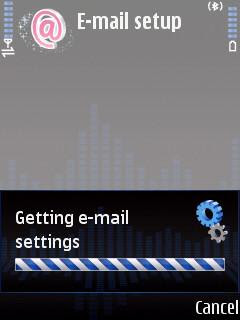
After a shaky start in which beta test version 3.0 of Nokia's email client was slowly rolled out across the globe, with some parts of the planet completely shut off from email.nokia.com, it looks like the site is now open for all.
That doesn't necessarily mean you can try it on your phone. There are still plenty of Symbian S60 Nokias that can't test Nokia Email.
So what's new for those who have a compatible phone? This is what Nokia has to say about it:
• Localization. We’re now localized into six different languages, including full support for international characters, which has been a very popular request from our beta testers from all around the world. This release localized in English, Finnish, German, Dutch, Latin American Spanish and Iberian Spanish.
• More email addresses. Now Nokia Email lets you get mail from up to 6 email addresses, each in its own mailbox yet all in one place, and makes composing from any account seamless.
• More phones. Nokia Email service is available on more of the most popular Nokia S60 devices, including many of the latest S60 3.2 devices like the N96 and the N78.
[I checked five minutes ago on email.nokia.com, but the N96 was not on the list of supported phones yet]
• Better mailbox management. When you delete an email on your Nokia phone, it will be deleted from your email account. We’ve enabled this for both IMAP and POP accounts.
Nokia Email Service is free during the beta trial, but will probably cost money once the test is over. HTML email doesn't work yet, folder support is a work in progress, push email sucks your battery dry real quick, the program starts and runs slow, and there are still bugs aplenty.
And instead of letting you download an installer, Nokia wants you to do an on-the-fly install from an SMS, probably to stop you from making a backup of the installer or sharing it with your friends. The people at Mobile Castle have fixed that problem, but you'll still have to sign up on the Nokia email site to make their email service work.
Not scared yet? Then give Nokia Email beta 3.0 a shot and send your feedback to Nokia's email blog.
• email.nokia.com
• Nokia Email beta 3.0 at Mobile Castle
Saturday 11 October 2008
We-Travel: new features, less bugs

We-Travel is a navigation program that uses the maps of OpenStreetMap. It's the first navigation application that has free maps and free voice navigation. We-Travel stores its maps on your phone, so you can navigate without keeping an active mobile internet connection running.
We-Travel is still new and experimental, but the new version shows its heading in the right direction. Changes in the latest version include smoother GPS and bluetooth and better looking maps.
• We-Travel.co.cc
Friday 10 October 2008
Metro: minor bug fixes, major city updates

The latest version of train, tram, bus, and subway navigator Métro comes with bug fixes and city updates.
Métro for Symbian S60 and Symbian UIQ helps you find the best connections between stations, bus and tram stops, tourist attractions and other places of interest. Métro can find the fastest route for you, or the route with the fewest connections. All major cities and lots of minor cities are covered.
The public transport data for Paris, Brussels, Porto and other cities was changed big time. Barcelona, Beijing, LA, Madrid, Montreal and other places were also updated.
Métro stores its public transport data on your phone, so you don't need a mobile internet connection to navigate the public transport routes and times. Métro integrates with your phone contacts to make it easier to plan routes.
More info and downloads at metro.nanika.net.
Thursday 9 October 2008
Less bugs in new version of Symbian calculator cCalc

cCalc is a free scientific calculator for Symbian with many functions, including programmable equations. Some bugs were fixed in version 1.13, with the Nokia E61, E62, and E71 in mind.
The cCalc website wasn't fully updated when I checked, but the new cCalc version is there.
• cCalc by Chua Welic
Wednesday 8 October 2008
New beta test version of Symbian file manager FExplorer

X-plore, ActiveFile, Y-Browser, SExplorer... there's no shortage of Symbian file managers out there.
FExplorer is one of them. The new beta test version (no changelog on the FExplorer site) needs a bit more work, though. The screenshot function requires an edit key, which is absent on most new Nokias. Its bluetooth manager doesn't work yet, and clicking "installed applications" just generates a text file with your installed programs in a format that's not at all pleasant to read.
The tools menu also has an entry with the enigmatic name "TEST TEST," which rotates the FExplorer screen by 90 degrees.
The basic functions of FExplorer work OK, but ActiveFile and X-plore do it better.
You need to hack your phone or "sign" FExplorer with a developer certificate for full functionality. To unleash the full potential of FExplorer, set your copy of Symbian free.
• FExplorer site
Tuesday 7 October 2008
VoIP and chat: is fring still on top? Nimbuzz has grown up, Talkonaut killed some bugs

In the mobile world of instant messaging and VoIP calls, fring is the best program for your Symbian phone, right? Well, maybe, but the competition doesn't sleep. Nimbuzz has turned into a pretty good program for Skype and other VoIP services. If Nimbuzz improves its user interface, they may even score high in the instant messaging department.
Nimbuzz lets you chat and call on Skype, and does voice calls with almost every VoIP service that handles standard SIP calls. Just like fring does.
Of course Nimbuzz connects to AIM, GoogleTalk, Jabber, MSN, and Yahoo, just like many other multi-network mobile instant messenger applications. Not just for chatting, but for file transfers and voice chats too.
Talkonaut does more or less the same as fring and Nimbuzz. Make that less the same, because Talkonaut lacks Skype. The latest version of Talkonaut has a few less bugs than before. But with a combination of Nimbuzz and fring you don't really need Talkonaut.
Choose your weapon:
• Nimbuzz
• Talkonaut
• fring
Monday 6 October 2008
Skype for mobile beta test version nowhere near ready: Nimbuzz and fring skype better than Skype itself

The beta test version of Skype's official mobile client moved up to Beta 2. A small step in the right direction, but still a long way to go.
Skype for mobile Beta 2 lets anyone receive calls, see who's online on Skype, and chat on Skype's own instant messaging network.
But making Skype calls, the real reason why you'd use this program, is limited to users in Denmark, Estonia, Finland, Poland, Sweden, UK, and the two biggest cities of Brazil.
So why bother with the official Skype program when you can simply use Nimbuzz or fring instead?
Chat and talk applications fring and Nimbuzz connect to all the major instant messaging networks, let you make SIP calls with just about every VoIP service available, and they do Skype as well. Making Skype calls, receiving Skype calls, Nimbuzz and fring let everybody skype without the geographical restrictions of Skype's own beta test program.
• Skype for mobile (crippled beta test version)
• Nimbuzz with Skype and much more
• fring with Skype and much, much more
Sunday 5 October 2008
Find free open Wi-Fi connections with FreeAir
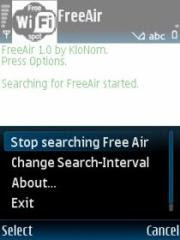
There are plenty of ways to let your Symbian phone find Wi-Fi connections, but what's the point if you have to find that really free open wireless router in between a jungle of access points that ask you for passwords or money or both?
FreeAir by KloNom makes things a lot easier by finding free and open wireless internet connections for you, so you don't have to deal with all the paid, locked, useless wireless background noise. You can tell FreeAir when to search, when not to search, and how often it should search. Keeping the search interval high keeps your list of free Wi-Fi connection options more accurate, keeping the search interval low makes your battery last longer. The choice is yours.
To run FreeAir you need to have Python installed. You'll also need to sign the .sis files or set your phone free to avoid Symbian's Signing Madness.
• FreeAir v1.0 on Mobile Castle
Saturday 4 October 2008
Mobile Calling Card Dialer saves pushing a bunch of buttons
 Update: This app died, just like Symbian.
Update: This app died, just like Symbian.
Calling from your mobile phone can be expensive, especially when roaming. Prepaid calling cards can save you lot of money, but you have to punch many, many, many buttons on your phone to stop your mobile operator from extorting their ridiculous roaming rates from you.
Enter Mobile Caling Card Dialer from self-proclaimed wannabee mobile geek Hamidou Diallo.
Mobile Calling Card Dialer is an application in mobile Java that simply does its not too demanding job. Let the program save the details of your calling cards and you no longer need to feed them into your phone again and again everytime you want to make a cheap call on the move.
• The Mobile Calling Card Dialer site
Direct links to the installer files so you can back 'em up and don't need to do an online on-the-fly install:
• Mobile Calling Card Dialer 2.0 .jar file
• Mobile Calling Card Dialer 2.0 .jad file
Update: This app died, just like Symbian.
Friday 3 October 2008
Nokia Chat: bug fixes, but no version for feature pack 2 yet

Nokia Chat is Nokia's instant messaging program that connects to a modest number of networks: Nokia's own chat network, GoogleTalk, and other Jabber-based IM networks.
Nokia Chat works with Symbian S60 version 3.1 (feature pack 1), version 3.0 (no feature pack), and Maemo OS2008, the Linux-based operating system for Nokia internet tablets N800 and N810.
It doesn't work on Symbian S60 version 3.2 (feature pack 2).
New in the latest version of Nokia Chat: auto-reconnecting (when the connection is lost), memory management, and a few other things should be less buggy now.
Nokia Chat doesn't work on ICQ, MSN, AIM, or Yahoo. For those networks you'll need a program like fring, Slick, Talkonaut, or eBuddy. All these programs also work on GoogleTalk too.
• Nokia Chat on the Nokia Beta Labs site
• Configure your PC IM client for the Nokia Chat Network
Thursday 2 October 2008
DivX Mobile Player 0.91

DivX Mobile Player for Symbian S60 and UIQ is a very simple program. It plays DivX movies, and nothing else. It's not nearly as good as CorePlayer (which plays almost anything you feed it), but DivX Player is free.
• DivX Player at www.divx.com
Wednesday 1 October 2008
Talkonaut and fring: similar programs for VoIP calls and chat

Mobile VoIP and instant messaging program Talkonaut used to have a spartan user interface, but is has improved a lot. Talkonaut supports many protocols and networks:
Chat, voice calls, file transfer: Jabber, Google Talk, ICQ, MSN, AIM and Yahoo.
VoIP calls: SIP (on almost all VoIP networks)
Talkonaut is very similar to fring. The main differences:
- Talkonaut can store and use multiple SIP accounts, fring stores only one.
- You can Skype with fring, but not with Talkonaut.
- The user interface of fring is easier to navigate.
- The built-in contact list of your phone is accessible from fring, but not from Talkonaut.
Talkonaut has a few other features that fring doesn't have and vice versa. To get the best of both worlds, just put both programs on your phone.
• talkonaut.com
• fring.com
Update: fring is no longer a multi-network messenger. They kicked 'em
all out, fring now only works on it's own fring network. My advice:
don't use fring.
|